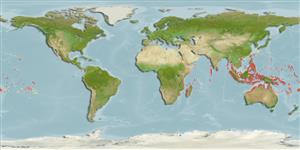Common names from other countries
>
Beloniformes (Needle fishes) >
Zenarchopteridae (Internally fertilized halfbeaks)
Etymology: Zenarchopterus: Particle zen, derived from zao = to give life + Greek, archos = anus + Greek, pteron = fin.
More on author: Valenciennes.
Environment: milieu / climate zone / depth range / distribution range
Ökologie
seewasser; süßwasser; brackwasser riff-verbunden; pH range: 7.0 - 8.0; dH range: 10 - ?; ozeanodrom (Ref. 51243); tiefenbereich 0 - 3 m (Ref. 86942). Tropical; 24°C - 28°C (Ref. 12468)
Indo-Pacific: Kenya, Mozambique, Seychelles, Madagascar, New Guinea, Solomon Islands, Australia, New Caledonia, Fiji, and Samoa. Reported from Sri Lanka (Ref. 6028) and Vanuatu (Ref. 13300). Also found in India, Malaysia, Thailand and Singapore (Ref. 43081).
Size / Gewicht / Alter
Maturity: Lm ? range ? - ? cm
Max length : 19.0 cm TL Männchen/unbestimmt; (Ref. 7050)
Kurzbeschreibung
Bestimmungsschlüssel | Morphologie | Morphometrie
Rückenflossenstacheln (insgesamt) : 0; Rückenflossenweichstrahlen (insgesamt) : 11 - 12; Afterflossenstacheln: 0; Afterflossenweichstrahlen: 12 - 13; Wirbelzahl: 42 - 43. Upper jaw distinctly wider than long. Snout uniform brown without any dark band on the midline. Pectoral fin shorter than head length. Lower jaw much shorter than head. Sixth and seventh anal rays of adult males greatly thickened and elongated, both rays reaching beyond the caudal base. Either dorsal ray 4 or 5 or both elongated and thickened.
Inhabit shallow water around mangrove in sheltered bays (Ref. 26367). Early juveniles are neustonic and float on the surface of estuarine mangroves (Ref. 43081).
Life cycle and mating behavior
Maturities | Fortpflanzung | Spawnings | Egg(s) | Fecundities | Larven
Collette, B.B., 1986. Hemiramphidae. p. 163-164. In J. Daget, J.P. Gosse and D.F.E. Thys van den Audenaerde (eds.) Check-list of the freshwater fishes of Africa (CLOFFA). ISNB, Brussels; MRAC, Tervuren; and ORSTOM, Paris. Vol. 2. (Ref. 6798)
IUCN Rote Liste Status (Ref. 130435)
CITES (Ref. 128078)
Not Evaluated
Bedrohung für Menschen
Harmless
Nutzung durch Menschen
Fischereien: kommerziell
Tools
Zusatzinformationen
Download XML
Internet Quellen
Estimates based on models
Preferred temperature (Ref.
115969): 26.2 - 29.3, mean 28.6 (based on 2318 cells).
Phylogenetic diversity index (Ref.
82804): PD
50 = 0.5000 [Uniqueness, from 0.5 = low to 2.0 = high].
Bayesian length-weight: a=0.00457 (0.00200 - 0.01044), b=3.03 (2.83 - 3.23), in cm Total Length, based on LWR estimates for this (Sub)family-body shape (Ref.
93245).
Trophic level (Ref.
69278): 2.9 ±0.5 se; based on size and trophs of closest relatives
Fishing Vulnerability (Ref.
59153): Low vulnerability (10 of 100).
